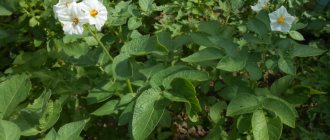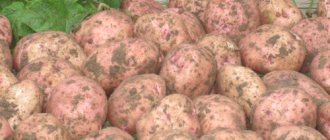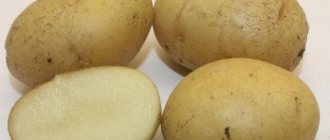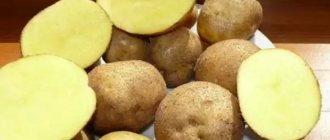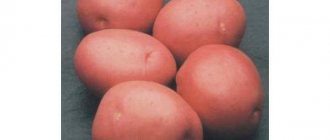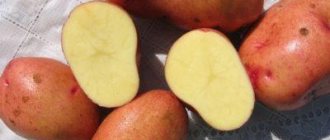Kamensky potato is an early-ripening table variety of domestic selection. Kamensky was developed by the Ural Research Institute of Agriculture. In 2009 it was included in the State Register of the Russian Federation. Recommended for cultivation in the following regions:
- Volgo-Vyatka;
- Ural;
- West Siberian.
In today’s article we will present a description of the variety, show photos of tubers and reviews from summer residents who were lucky enough to cultivate the Kamensky variety.
Characteristics of Kamensky
Kamensky is an early ripening variety. Ripening occurs 50-60 days after planting the material.
The tubers have a red, rough shell. There are small small eyes located on the surface. The shape of the root crops is oval, oblong. The color of the pulp is dull yellow, sometimes yellow. Does not change its color when damaged or heat treated.
Due to the high starch content (approximately 16-18%), root vegetables quickly crumble during heat treatment.
The average weight of a mature root crop is 110-130 g. There are also specimens weighing up to 180 g.
The Kamensky variety is characterized by the following properties:
1. Precocity. As noted earlier, the variety ripens 2 months after planting.
2. High yield. From 1 hectare of planting you can harvest 50-55 tons (500-550 quintals) of high-quality potatoes. It is also worth noting that this is a fairly high indicator, given the early ripening of the variety.
3. Drought resistance. Kamensky can tolerate short-term droughts without pain.
4. Taste qualities. Kamensky has good taste. On a 5-point scale he is given 4.8.
5. Resistant to mechanical damage. Potatoes are not afraid of long-term transportation and are suitable for mechanical harvesting.
6. Versatility. Tubers are suitable for making purees and salads. Kamensky also feels great fried and in soups.
7. Keeping quality. Tubers of this variety are stored very well. The shelf life percentage, under favorable conditions, reaches 97%.
The bush itself is tall and of intermediate type. Stems are semi-erect, less often erect. The plant is covered with medium-sized leaves of a dark green color. The leaves have pronounced wavy edges.
The inflorescence includes a large number of fairly large flowers of a red-violet hue.
The root system of the bush is very developed. One plant can form up to 25 medium-sized root crops.
Reviews from gardeners
Alexey Ivanovich, 53 years old, Orenburg region
I have been growing Kamensky for two years in a row. Does not require special care. Root crops grow medium in size and have the same shape. The Colorado potato beetle is practically not affected. Knowing about the high risk of wireworm damage, in the fall I add compost from chicken manure to the soil so that by spring it will completely rot and the parasite will disappear. The taste is excellent. I especially like fried and boiled potatoes in their jackets. If you don’t have time to care for your vegetable crop, then Kamensky is the best option.
Irina Aleksandrovna, 46 years old, Krasnodar region
Planted Kamensky last year for the first time. I chose it because of its high resistance to drought, since it is not possible to irrigate the garden very often. The vegetable crop met all expectations. Over the entire period, I watered the potatoes fully 4 times. The harvest was good. It softens quickly during cooking, so cooking with it is a pleasure. For those who have not yet selected planting material for the new planting season, I recommend considering Kamensky.
Advantages and disadvantages of the variety
The variety has been cultivated for a long time in Russia and in neighboring countries, and summer residents have already been able to highlight its main advantages and disadvantages. Among the advantages it is worth noting:
- Productivity does not depend greatly on climatic conditions.
- Kamensky has excellent taste.
- The variety is not picky about soil type.
- Kamensky is less likely than other varieties to be attacked by the Colorado potato beetle.
- Does well in dry conditions.
- Thanks to the thick shell, root crops are not damaged during transportation and during mechanical harvesting.
- Has high keeping quality.
There is only one significant drawback: Kamensky is not protected from potato nematode, which infects it more often than other varieties.
Description of the variety. Starch content
Roots:
- The peel is red, rough, and has a pronounced mesh surface;
- Medium ocelli, superficially located;
- The flesh varies from pale yellow to yellow when cut;
- Tubers are oval, oval-elongated;
- The cut flesh does not darken;
- Contains a high level of starch - from 16.5 to 18.9%;
- Average weight from 110 to 130 grams.
Video review of Kamensky potatoes:
Shoots:
- The bush is stem-shaped, erect, intermediate type, dark green in color;
- Dark green leaves of medium to large size, rather rigid, with pronounced wavy edges;
- The corolla is large in size, with a pronounced anthocyanin color inside.
Correct fit
They begin to plant planting material when the soil has warmed up to +8-10 C to a depth of at least 10 cm. In the Southern regions, planting begins in early May, in the Central part of the country closer to the 20th of the same month, but in the North closer to the beginning of summer.
Also, our grandmothers very often found their way around the birch tree. If buds have begun to bloom on this tree, then the soil is ready to “receive” planting material.
Only healthy tubers are allowed for planting. There should be no growths, stains, cuts, cracks, etc. on their surface. Also, it is ideal if medium potatoes weighing at least 60, but not more than 80 g are selected.
Planting is carried out according to the standard pattern: 35x70 cm. The large distance between the rows ensures good natural aeration and illumination of the bushes.
If the soil is poor in organic matter, then during planting you can additionally fertilize each hole. It is recommended to use wood ash as fertilizer. If it is not there, humus will be an excellent alternative.
Growing and caring for potatoes
Potatoes are planted in the spring, when the soil warms up to 12-18 degrees. Before sprouting purchased or harvested potatoes, sort through them. Discard rotten, damaged tubers, as well as root vegetables with weak sprouts. It is necessary to germinate planting material in warm rooms.
The first week, potatoes should germinate at a temperature of +20 degrees, the second week at a temperature of +12-15 degrees. The measure is necessary to maintain the strength of the sprouts until the tubers are planted.
Planting and care
It is recommended to plant root crops in early May, when the earth has finally warmed up. Tubers can be placed in holes or furrows. Planting depth is 10-15 centimeters. Add a glass of wood ash to each hole, which repels wireworms and serves as an excellent fertilizer.
Maintain a distance between root crops of 30-35 centimeters. Leave 60-70 centimeters between rows of potatoes. If the soil is contaminated with nematodes, treat it with Nemabakt (packaging 10 liters, solution consumption 1 liter per meter).
After planting, when the vegetable crop grows up to 10 centimeters above the ground, it needs to be hilled and irrigated. For potatoes, it is recommended to install drip irrigation. It is necessary to hill up the bushes a second time before flowering begins, when the bushes have not completely decomposed. Fertilize twice.
During the growth period, use nitrogen fertilizers, and during flowering, potassium and phosphorus fertilizers (fertilizer consumption per 1 hundred square meters is 1 kg). Water during growth and flowering periods. Two weeks before digging, irrigation is stopped.
Harvest and storage
Dig up root vegetables in dry weather. Dry and sort the collected potatoes. Discard rotten and spoiled tubers. Store the harvest in a dry and cool cellar or warehouse. Air humidity in the room should not exceed 80%. The temperature in the storage should be within 0-+2 degrees. Place vegetables in wooden containers, boxes or nets. Air must circulate between the containers to prevent mold from forming. In January, you need to sort through the potatoes and remove the sprouts.
Care
The variety is not afraid of drought, but this does not mean that it does not need to be watered. On the contrary, timely watering will help to obtain maximum yield. Kamensky is watered only three times per season:
- After the tops appear.
- Before flowering.
- Immediately after flowering.
It is also worth noting that experienced gardeners do not recommend watering Kamensky after flowering has ended. The thing is that during this period the late blight fungus is activated, for which moisture is an ideal environment for spread.
Also, do not forget about hilling. It allows you to increase productivity by 20-30%. This is achieved thanks to the additional stolons that are formed during hilling. Also, during hilling, the soil is loosened and weeds that have a depressing effect on the crop are removed.
Disease and pest control
One of the care methods involves mandatory protection from frost. Since the Kamensky variety is an early-ripening species, it is often planted in May, when the onset of return frosts is possible. To prevent the tubers from freezing before they adapt to new conditions, the sprouts are covered a little with soil.
Insect parasites that are dangerous for potato plantings:
- Colorado beetle;
- nematode;
- Chafer.
Kamensky potatoes, the description of the variety and photos of which are discussed in detail, are relatively resistant to the invasion of the Colorado potato beetle.
If the beetle does appear, then various measures are carried out sequentially:
- insects living on plants are collected by hand, then they are placed in containers filled with kerosene for complete destruction;
- the bushes from which insects are collected are treated with special chemicals, such as Prestige, Cruzero, Komandor;
- As a preventive measure, plants are sprayed with chemical compounds, for example, Aktara or Canofora.
The main disadvantage of using chemicals is that insects become accustomed to a group of drugs, so it is not recommended to use the same products in the same area. In addition, each season it is necessary to change planting zones.
As folk remedies, they recommend watering with wood ash, onion or garlic peels, and tobacco infusion. Some of the recipes have been known for a long time. Treatment with plant raw materials helps get rid of beetle larvae, as well as prevent the development of fungal or bacterial diseases.
The enemy of the variety is the potato nematode. The parasite is a microscopic worm that infects the roots and tubers of potatoes. The nematode can also penetrate the stems, exhaust them and stop the growth of the bush.
After the appearance of the nematode, the tubers begin to rot and cannot be used for food or stored. Nematodes also carry viral diseases, so the damage caused by the appearance of the insect can be considered extensive.
Fighting nematodes is quite difficult. The worm is resistant to some insecticides. It parasitizes underground, so its timely detection is difficult.
To protect potato plantings, various preventive measures are carried out.
A nematode can be detected by external signs:
- yellowing of bushes;
- deformation of shoots;
- the release of tiny flowers instead of large buds.
The deformation of the stem looks like swelling from the inside. If growths form on the lower part of the stem, this means that a stem nematode has settled on the plant.
As for wilting, it manifests itself at the initial stage of reproduction of the root nematode. The nematode is treated with contact-type chemicals. These are drugs such as Karbofos, Lindane or Phosfamide.
At the initial stage, fumigants, that is, chemicals that affect the insect body by releasing gas, will help get rid of the worm. These are drugs such as Chloropicrin, Carbocation. In addition, the worm is treated with targeted drugs: Metarizin, Bazim.
Folk remedies in the fight against nematodes are practically not used due to low efficiency. These are known as preventive measures. The best results in eliminating larvae are obtained by treating the soil with boiling water. This procedure can be carried out in small areas where plantings include several dozen crops, but it is not practical to treat large potato areas with boiling water.
The nematode causes enormous damage to potatoes. Only timely prevention and adherence to agrotechnical practices will help to cope with this parasite.
Description
The Kamensky potato variety was bred specifically for regions with a temperate climate, especially for the Ural, West Siberian and Volga-Vyatka regions. At the same time, its unpretentiousness and endurance make it possible to obtain high yields in any conditions; in Moscow and the region, and even more so in the southern regions with their fertile soils and warm climate, gardeners receive record yields.
Potatoes Kamensky
Kamensky belongs to the early ripening potato varieties; the first tubers can be dug up 1.5 months after planting and young potatoes can be eaten. The green part of the plant is very lush, with a thick trunk and elastic, bright leaves. The tubers are round and slightly elongated in shape. The peculiarity of the variety is its double thick peel of bright pink color, thanks to this property the potatoes can be stored for a very long time. Inside the fruit is pale yellow and dense. High starchy content allows potatoes to be used for frying and boiling; they do not fall apart. In general, this variety belongs to the table variety, which allows you to cook it in any way.
Salt lamp - benefits and harm. How to choose a salt lamp and instructions for use
Characteristics of Kamensky potatoes
| Parameter | Meaning |
| Productivity, c/ha | Maximum 550 |
| Maturing period, months | 2 |
| On 1 branch fruits grow, pieces | Maximum 25 |
| Weight of 1 tuber, kg | 0.13 |
| Starch content, % | 18 |
| Bush height, m | 0.7 |
| Safety in winter, % | 97 |
Advantages of the variety
- High yield
- Intensive early tuberization
- Wide adaptability
- Excellent quality
- High uniformity of tubers and nests
- Large commercial tubers
- Resistance to the Colorado potato beetle
- Virus resistance
- Good shelf life and resistance to mechanical damage
- High starchiness
- Great taste
General information about potatoes
The vegetable crop was bred at the Agricultural Research Institute in the Urals. Scientists managed to develop one of the resistant varieties in the Russian Federation in a very short time. After several years of testing, in 2009 it was included in the state register of breeding achievements of Russia.
It is recommended to grow the crop in the West Siberian region, as well as in the Urals. The vegetable belongs to varietal varieties, so after harvesting it can be planted the next year, no quality characteristics change.
The above-ground part is inedible and is intended for photosynthesis. Bush-shaped plant. The stems grow erect, thick, and pigmentation can be seen over the entire surface. With strong growth, the bushes begin to lie on the ground.
The leaf blades are medium in size and painted a rich green color. The surface of the leaves is hard with strong veining. The leaf blades are wavy at the edges. The inflorescences are large, a large number of flowers are formed. The formed corolla is distinguished by a red-violet hue.
Root crops of the Kamensky variety are formed in an oval-elongated shape. On average, the mass of a tuber reaches 100-130 grams. The peel is painted a rich pink color, with tints of red. The surface of the potato is rough. The eyes are yellow, small, and located on the surface. 15-25 fruits are formed under the bush. The size of the tubers is uniform, peas are not observed.
The pulp is dense, juicy, and light yellow in color. The starch content is in the range of 16-19%. Boils quickly. The taste is excellent. After heat treatment it does not darken. Officially, the ripening period is set at 50-60 days, but gardeners note that potatoes are ready for consumption already 40-45 days after planting.
How to plant
They plan to plant Kamensky potatoes no earlier than the May holidays - perhaps at the beginning or in the middle of the month. The place should be open, without shade or stagnant water. The variety grows on different types of soil, but for a good harvest you must first dig up the soil and fertilize it with compost or humus (a bucket per square meter). If there is too much clay in the ground, sawdust or sand is embedded in it (up to 5 kg for the same area).
3-4 weeks before planting Kamensky potatoes, the seeds should be transferred to a lighted and cool room (15 degrees), laid in two layers, periodically turned over and sprayed with water. A day before planting, they are treated with a fungicide, for example, “Quadris”.
Standard landing pattern:
- Level the surface.
- Mark several furrows at intervals of 60 cm.
- Dig holes up to 10 cm deep at a distance of 30-40 cm.
- Lay out the tubers and add a pinch of wood ash.
- Sprinkle with soil.
- Water with settled water.
Important! When planning planting, it is better to mark the furrows in the direction from north to south. Then the bushes will receive maximum sunlight.
Harvesting and storage
Like any potato variety, Kamensky must be harvested very carefully so as not to damage the fruits. Considering its productivity, you need to use a pitchfork and dig in the middle between the bushes, dumping a layer of earth with tubers in the aisle. The selected fruits are placed in wooden or plastic boxes not all the way to the top so that they can be stacked.
The early ripening table variety is not subject to long-term storage, but the “lifespan” of the tubers can be extended if the boxes are placed in a cool, dry cellar. In this case, the vegetables will be preserved for 2-3 months, especially if you sort them weekly. It's also a good idea to store potatoes in the vegetable drawer of your refrigerator.
The Kamensky potato represents a new level of control of the Colorado potato beetle - there is no need to create insecticides, but it is enough to select a variety with properties that interfere with pests. At the same time, potatoes are perfectly boiled, fried and baked and have an excellent taste.
Necessary conditions for cultivation
To grow the Kamensky variety, select a site with suitable lighting, humidity and soil composition.
Region of growth
Kaminsky potatoes are suitable for growing in northern regions. Thanks to its early ripening, it manages to produce a good harvest that is not affected by unfavorable weather conditions.
In temperate and southern regions, it allows you to harvest a double harvest per season. In the south, potatoes ripen faster.
Illumination, temperature, humidity
Potatoes prefer good and constant light. The optimal air temperature for growth is 20 – 24 °C. Regular watering ensures additional formation of tubers and absorption of minerals. However, frequent flooding of the soil contributes to fruit rotting, so it is recommended to install drainage.
Optimal soil composition
The Kamensky variety is not picky about the choice of soil. It survives on any soil. A favorable composition for it is a mixture of peat, humus and sand. On loose and airy soils, the yield is higher than on heavy and wet soils.
